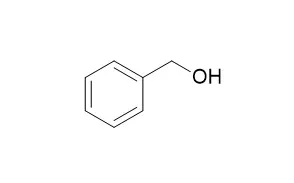| In vitro: |
| Pharmaceutical Research, 1997, 14(6):725-729. | | The effect of benzyl alcohol on recombinant human interferon-gamma.[Pubmed: 9210188] | The goal of this study was to investigate the conformational change and aggregation of recombinant human interferon-gamma (rhIFN-gamma) as a result of interaction between Benzyl alcohol and the protein. The effects of buffer concentration, buffer species, ionic strength, rhIFN-gamma and Benzyl alcohol concentrations on the dynamics of the interaction in liquid formulations were also examined.
METHODS AND RESULTS:
The effect of Benzyl alcohol on the secondary and tertiary structure of rhIFN-gamma in succinate and acetate buffers was studied using far-UV and near-UV circular dichroism spectrophotometry, respectively. Dynamic light scattering was employed to detect aggregate formation due to the interaction of Benzyl alcohol with rhIFN-gamma.
The addition of Benzyl alcohol at 0.9% (w/v) in various liquid rhIFN-gamma formulations induced changes in circular dichroism (CD) spectra of the protein in the near-UV region, while the CD spectra in the far-UV region remained unaltered. There were gradual decreases in ellipticity with time throughout the near-UV CD spectra. The decreases in near-UV ellipticity induced by Benzyl alcohol were accompanied by the formation of high molecular weight aggregates as measured by dynamic light scattering. Loss in near-UV ellipticity was accelerated at lower protein concentration and by increasing buffer or Benzyl alcohol concentration. It was also faster in succinate than in acetate buffer. Formulation ionic strength did not affect the CD spectral changes in both the near- and far-UV regions.
CONCLUSIONS:
Interaction between Benzyl alcohol and rhIFN-gamma is formulation dependent. Protein concentration, buffer species, buffer concentration, and preservative concentration play a significant role in determining the extent of the interaction and consequently the stability of the product. | | Journal of Pharmaceutical ences, 2010, 94(2):382-396. | | Effects of Benzyl Alcohol on Aggregation of Recombinant Human Interleukin-1-Receptor Antagonist in Reconstituted Lyophilized Formulations.[Reference: WebLink] | A major limitation in the successful development of multidose protein formulations is protein aggregation induced by antimicrobial preservatives such as Benzyl alcohol, which are included to maintain product sterility.
METHODS AND RESULTS:
Studies were conducted to evaluate the strategy of developing lyophilized formulations of a therapeutic protein, recombinant human interlukin-1 receptor antagonist (rhIL-1ra), to be reconstituted with a bacteriostatic amount (0.9% w/v) of Benzyl alcohol in water. The strategy was based on the following hypotheses. The first was that Benzyl alcohol would foster aggregation during reconstitution of the lyophilized sample. The second hypothesis was that the extent of Benzyl alcohol-induced protein aggregation would correlate directly with the degree of structural perturbation of rhIL-1ra in the dried solid after lyophilization. Differential structural retention of rhIL-1ra in the dried solid was obtained by using a combination of formulation variables important for lyophilization and included: protein concentration, type of stabilizer, and presence or absence of NaCl. Infrared spectroscopic analysis of the lyophilized samples indicated that high initial solution protein concentration and the stabilizer sucrose minimized structural perturbation of rhIL-1ra during lyophilization. In contrast, NaCl was destabilizing. Reconstitution of the dried solid with 0.9% (w/v) Benzyl alcohol caused a greater degree of protein aggregation than reconstitution with water, confirming our first hypothesis. In support of our second hypothesis, the extent of aggregation induced by Benzyl alcohol during reconstitution was strongly modulated by the degree of retention of native rhIL-1ra secondary structure during lyophilization. During storage of the reconstituted lyophilized samples at room temperature, Benzyl alcohol did not accelerate aggregation of rhIL-1ra.
CONCLUSIONS:
This study demonstrated that for development a multidose lyophilized protein formulation involving reconstitution with a solution of Benzyl alcohol, protein structural perturbations during freeze-drying should be minimized with a stabilizing excipient and appropriate choice of protein concentration and tonicity modifier. Furthermore, postreconstitution storage at reduced temperature (e.g., room temperature or 4°C) could minimize the risk of preservative-induced protein aggregation. |
|






 Cell. 2018 Jan 11;172(1-2):249-261.e12. doi: 10.1016/j.cell.2017.12.019.IF=36.216(2019)
Cell. 2018 Jan 11;172(1-2):249-261.e12. doi: 10.1016/j.cell.2017.12.019.IF=36.216(2019) Cell Metab. 2020 Mar 3;31(3):534-548.e5. doi: 10.1016/j.cmet.2020.01.002.IF=22.415(2019)
Cell Metab. 2020 Mar 3;31(3):534-548.e5. doi: 10.1016/j.cmet.2020.01.002.IF=22.415(2019) Mol Cell. 2017 Nov 16;68(4):673-685.e6. doi: 10.1016/j.molcel.2017.10.022.IF=14.548(2019)
Mol Cell. 2017 Nov 16;68(4):673-685.e6. doi: 10.1016/j.molcel.2017.10.022.IF=14.548(2019)